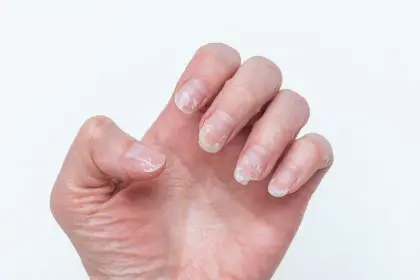When doctors examine patients, they often look beyond the presenting symptoms to gather additional diagnostic information. Fingernails, frequently overlooked by patients, provide physicians with valuable insights into overall health status and potential underlying conditions.
These keratinized surfaces serve as visible windows into bodily systems, often reflecting changes occurring elsewhere that might otherwise remain undetected during routine examinations.
Nail color variations
The color of healthy nails typically appears consistently pink due to the blood vessels beneath the nail bed. Deviations from this normal coloration often signal specific health concerns.
Bluish discoloration: Poor oxygen circulation, potentially indicating cardiovascular or respiratory issues. This cyanotic appearance warrants further investigation, particularly in patients with shortness of breath or fatigue.
Pale or whitish nails: Possible anemia, liver dysfunction or heart failure. The reduced color intensity reflects changes in blood supply or composition.
Yellow discoloration: Beyond common fungal infections, persistent yellowing may indicate respiratory conditions like bronchitis. In patients with diabetes or thyroid disorders, this discoloration sometimes appears as an early warning sign.
These color changes rarely exist in isolation—they typically accompany other symptoms that help physicians narrow potential diagnoses.
Shape abnormalities
The contour and shape of nails provide equally important diagnostic clues:
Clubbing: When fingertips enlarge and nails curve downward around the tips, doctors consider chronic lung conditions, inflammatory bowel diseases or heart disorders. This gradual transformation reflects the body’s response to chronic oxygen deficiency.
Spoon-shaped nails: Called koilonychia in medical terminology, this inward curving resembling a spoon often correlates with iron deficiency anemia. The concave shape develops gradually as iron stores deplete.
Curved or bent nails: May indicate vitamin deficiencies or circulatory issues affecting nail formation.
These shape changes often progress slowly, making them valuable indicators of chronic conditions developing over time.
Surface texture changes
Nail surface irregularities often reflect systemic or dermatological conditions:
- Small pits or depressions frequently appear in patients with psoriasis, eczema or certain autoimmune disorders
- Horizontal ridges (Beau’s lines) often form after severe illness, marking periods when nail growth temporarily paused
- Vertical ridges, while common with aging, can become more pronounced with nutritional deficiencies
- Splitting or peeling may indicate dryness or external damage but sometimes points to thyroid dysfunction
Texture abnormalities provide temporal information about when the body experienced stress or illness, functioning as a biological timeline physicians can reference.
Concerning dark markings
Dark streaks or spots under nails require particular attention as they sometimes indicate serious conditions:
Linear melanonychia: Dark lines running from cuticle to tip may represent benign pigment changes, particularly in individuals with darker skin. However, they occasionally signal subungual melanoma, a dangerous form of skin cancer.
Splinter hemorrhages: Tiny blood streaks beneath nails sometimes indicate minor trauma but can also suggest endocarditis or vasculitis, particularly when they appear across multiple nails without injury.
Physicians typically consider patient risk factors, the pattern of discoloration, and recent activities when evaluating these markings.
Nail bed inflammation
The area surrounding and under nails often reflects immune system function:
Paronychia: Infected, swollen nail folds indicate bacterial or fungal infection. Recurring infections may signal diabetes, compromised immunity or excessive moisture exposure.
Redness and swelling: Inflammation around nails can represent infection but also appears in autoimmune conditions that affect connective tissues.
These signs help physicians evaluate the body’s response to pathogens and identify patients who might require further immune system assessment.
Nutritional indicators
Nails develop slowly, making them reliable markers for chronic nutritional status:
Brittle, thin nails: Often associated with iron, biotin or protein deficiencies. When combined with other symptoms like fatigue or hair loss, these changes prompt nutritional screenings.
White spots: Though often caused by minor trauma, persistent white spots across multiple nails sometimes indicate zinc or calcium deficiencies.
Slow growth: Stunted nail development may reflect overall metabolic status, including thyroid function and nutritional intake.
These manifestations particularly help physicians identify subtle nutritional issues before they cause more serious complications.
Systemic disease markers
Certain nail patterns correlate strongly with specific medical conditions:
Terry’s nails: Mostly white with a narrow pink band at the tip, these frequently appear in patients with liver disease, cirrhosis or sometimes congestive heart failure.
Half-and-half nails: With the proximal half white and distal half red or brown, these often indicate kidney disease.
Yellow nail syndrome: Thickened, yellow, slow-growing nails with curved edges suggest lymphatic system disorders or respiratory conditions.
For patients with chronic illnesses, nail examinations provide non-invasive monitoring of disease progression and treatment response.
When to seek medical attention
Patients should consult health care providers about nail changes including:
- New dark streaks or spots
- Significant color changes affecting multiple nails
- Nail separation from the nail bed
- Thickening with yellowing or crumbling
- Persistent pain or swelling around nails
- Sudden appearance of horizontal ridges
While many nail abnormalities represent harmless variations, others provide the first visible evidence of underlying conditions requiring prompt attention.
Fingernails represent more than aesthetic concerns—they function as accessible diagnostic tools reflecting internal health status. Regular observation of nail appearance offers both patients and physicians valuable information that complements other clinical assessments and laboratory findings.







